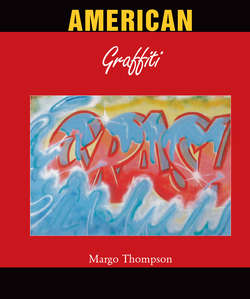Читать книгу American Graffiti - Margo Thompson - Страница 3
На сайте Литреса книга снята с продажи.
Introduction
Authenticity
ОглавлениеSince the early 1970s, when writers first decorated the outsides of subway cars with increasingly large and elaborate pieces, graffiti found favour among some urban intellectuals as a legitimate form of visual culture that gave voice to a racial underclass. In 1973, Pop artist Claes Oldenburg expressed his delight with the trend:
You’re standing there in the station, everything is gray and gloomy, and all of a sudden one of those graffiti trains slides in and brightens the place like a big bouquet from Latin America.[6]
Pulitzer-prize winner Norman Mailer wrote a book celebrating subway writing called The Faith of Graffiti in 1974. The title came from a remark writer CAY 161 made to Mailer, that ‘the name is the faith of graffiti’: the tag is fundamental, unique to its owner, not to be borrowed or copied. Mailer described the way graffiti had spread over the urban environment:
[I]t looked as if graffiti would take over the world, when a movement which began as the expression of tropical peoples living in a monotonous iron-gray and dull brown brick environment, surrounded by asphalt, concrete, and clangor, had erupted biologically as though to save the sensuous flesh of their inheritance from a macadamization of the psyche, save the blank city wall of their unfed brain by painting the wall over with the giant trees and pretty plants of a tropical rain-forest, and like such a jungle, every plant large and small spoke to one another, lived in the profusion and harmony of a forest.[7]
Some writers formed collectives: United Graffiti Artists was organised with the help of Hugo Martinez, a sociology student at City College, in 1972. They exhibited tags on canvases at the Razor Gallery in 1973. Peter Schjeldahl, reviewing the Razor show for The New York Times, judged the paintings as lacking in structure, but strong in the use of colour, and he singled out a few artists for their especially striking tags in the collaboration to which all the UGA members contributed. Most significantly, he observed that the works on canvas extended the ‘show-off ebullience’ of the tags seen city-wide on trains and walls. The efforts of the ‘ghetto kids’, with their ‘volcanic energies’, were ‘unstoppable’. Those ‘youths, having found an exciting outlet for their rage for identity, are not likely to drop graffiti’, Schjeldahl predicted.[8] The taggers’ motivation to expression their identity gave writing its legitimacy. Because tags were uninfluenced by formal training or high cultural references but were clear, forceful declarations of ego, they had an authentic quality. To Schjeldahl, the tag was all about asserting the subjective presence of the writer, but the style with which it was executed was more difficult to evaluate because it had no reference outside writing culture. It was inevitable that the distinction between writer and tag would collapse immediately. Tags and writers spoke for themselves in a visual idiom of their own, a form of subcultural communication impervious to whomever else might be looking on.
On canvas, however, the tag seemed less a matter of faith than a trademark reproduced on demand, and this threatened the authenticity attributed to illegal graffiti. In the studio, writers no longer worked only for themselves and their peers, but for a broader public. Furthermore, the paintings were evidence that they now wanted to please this audience, whereas their tags in the subways aggressively claimed the space in a way that many perceived as menacing.
6
Quoted in Richard Goldstein, “This Thing Has Gotten Completely Out of Hand,” New York, 26 March 1973, 33.
7
Norman Mailer, The Faith of Graffiti (New York: Praeger, 1974), unpaged.
8
Peter Schjeldahl, “Graffiti Goes Legit – But the ‘Show-off’ Ebullience Remains,” New York Times, 16 September 1973, 27.
